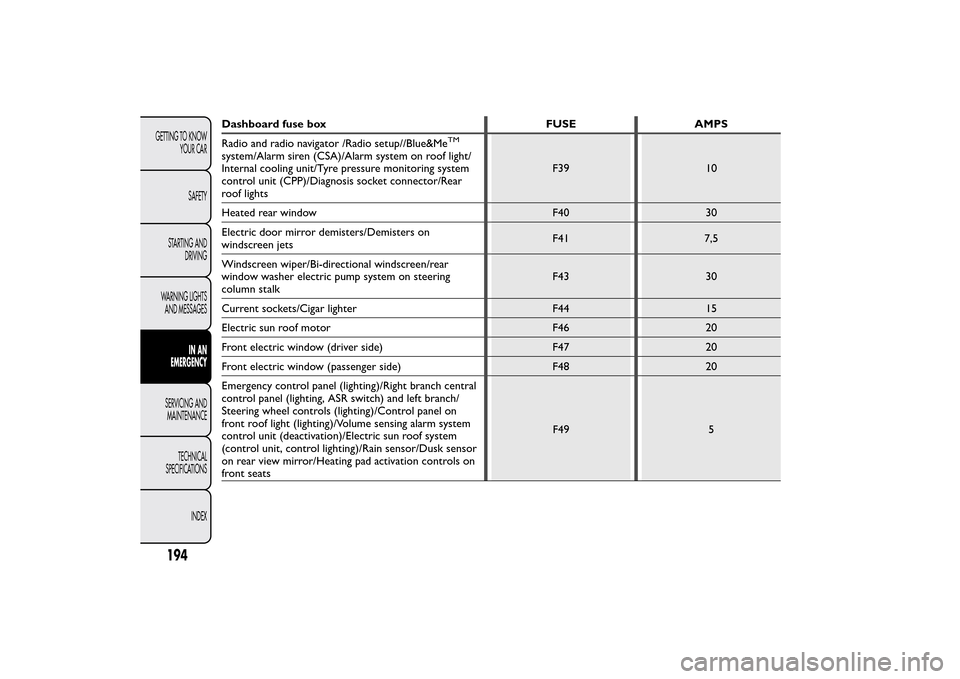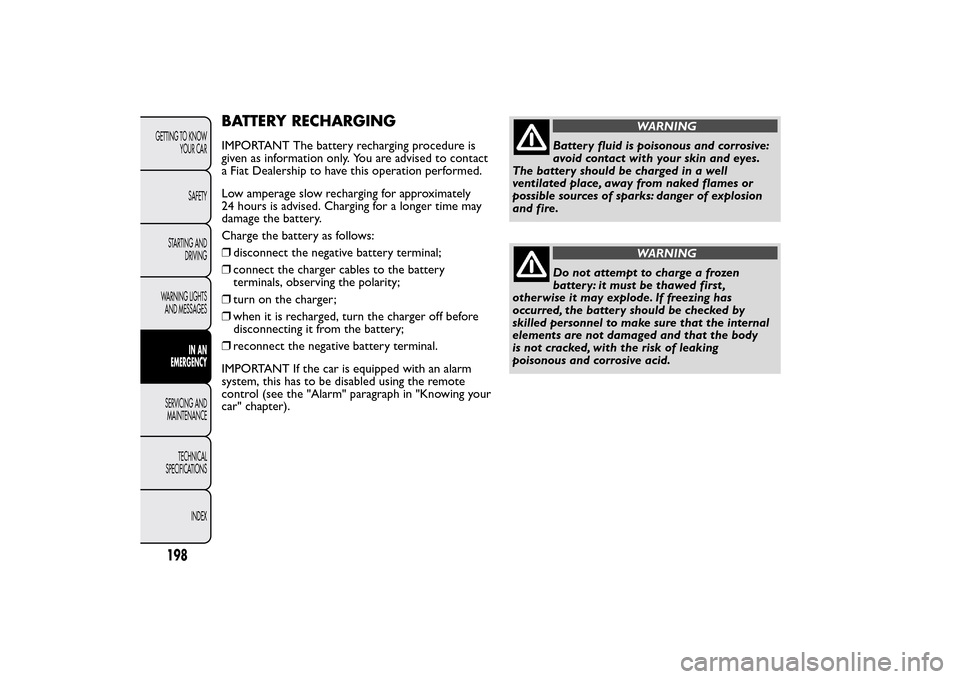Page 198 of 275

Dashboard fuse box FUSE AMPS
Radio and radio navigator /Radio setup//Blue&Me
TM
system/Alarm siren (CSA)/Alarm system on roof light/
Internal cooling unit/Tyre pressure monitoring system
control unit (CPP)/Diagnosis socket connector/Rear
roof lightsF39 10
Heated rear window F40 30
Electric door mirror demisters/Demisters on
windscreen jetsF41 7,5
Windscreen wiper/Bi-directional windscreen/rear
window washer electric pump system on steering
column stalkF43 30
Current sockets/Cigar lighter F44 15
Electric sun roof motor F46 20
Front electric window (driver side) F47 20
Front electric window (passenger side) F48 20
Emergency control panel (lighting)/Right branch central
control panel (lighting, ASR switch) and left branch/
Steering wheel controls (lighting)/Control panel on
front roof light (lighting)/Volume sensing alarm system
control unit (deactivation)/Electric sun roof system
(control unit, control lighting)/Rain sensor/Dusk sensor
on rear view mirror/Heating pad activation controls on
front seatsF49 5
194GETTING TO KNOW
YOUR CAR
SAFETY
STARTING AND
DRIVING
WARNING LIGHTS
AND MESSAGES
IN AN
EMERGENCY
SERVICING AND
MAINTENANCE
TECHNICAL
SPECIFICATIONS
INDEX
Page 199 of 275
Dashboard fuse box FUSE AMPS
Internal cooling unit/Radio setup/Cruise Control lever/
Blue&Me
TM
system control unit/Parking sensor control
unit (NSP)/Air pollution sensor (AQS)/Automatic
climate control system/Electric door mirrors
(adjustment, folding)/Tyre pressure monitoring system
control unit (CPP)F51 5
Rear window wiper F52 15
Instrument Panel (NQS) F53 7,5
195GETTING TO KNOW
YOUR CAR
SAFETY
STARTING AND
DRIVING
WARNING LIGHTS
AND MESSAGESIN AN
EMERGENCYSERVICING AND
MAINTENANCE
TECHNICAL
SPECIFICATIONS
INDEX
Page 200 of 275
Engine compartment fuse box FUSE AMPS
Main beam headlights F14 15
Left/right fog light/cornering light F30 15
Climate control fan F08 40
Headlight washer pump F09 30
Acoustic warning F10 10
Additional heater (PTC1) F15 30
Air conditioning compressor F19 7,5
Fuel pump F85 15
196GETTING TO KNOW
YOUR CAR
SAFETY
STARTING AND
DRIVING
WARNING LIGHTS
AND MESSAGES
IN AN
EMERGENCY
SERVICING AND
MAINTENANCE
TECHNICAL
SPECIFICATIONS
INDEX
Page 201 of 275
Luggage compartment fuse box FUSE AMPS
Front right seat movement F1 30
Front left seat movement F2 30
Front left seat heating F3 10
Front right seat heating F6 10
197GETTING TO KNOW
YOUR CAR
SAFETY
STARTING AND
DRIVING
WARNING LIGHTS
AND MESSAGESIN AN
EMERGENCYSERVICING AND
MAINTENANCE
TECHNICAL
SPECIFICATIONS
INDEX
Page 202 of 275

BATTERY RECHARGINGIMPORTANT The battery recharging procedure is
given as information only. You are advised to contact
a Fiat Dealership to have this operation performed.
Low amperage slow recharging for approximately
24 hours is advised. Charging for a longer time may
damage the battery.
Charge the battery as follows:
❒disconnect the negative battery terminal;
❒connect the charger cables to the battery
terminals, observing the polarity;
❒turn on the charger;
❒when it is recharged, turn the charger off before
disconnecting it from the battery;
❒reconnect the negative battery terminal.
IMPORTANT If the car is equipped with an alarm
system, this has to be disabled using the remote
control (see the "Alarm" paragraph in "Knowing your
car" chapter).
WARNING
Battery fluid is poisonous and corrosive:
avoid contact with your skin and eyes.
The battery should be charged in a well
ventilated place, away from naked flames or
possible sources of sparks: danger of explosion
and fire.
WARNING
Do not attempt to charge a frozen
battery: it must be thawed first ,
otherwise it may explode. If freezing has
occurred, the battery should be checked by
skilled personnel to make sure that the internal
elements are not damaged and that the body
is not cracked, with the risk of leaking
poisonous and corrosive acid.
198GETTING TO KNOW
YOUR CAR
SAFETY
STARTING AND
DRIVING
WARNING LIGHTS
AND MESSAGES
IN AN
EMERGENCY
SERVICING AND
MAINTENANCE
TECHNICAL
SPECIFICATIONS
INDEX
Page 203 of 275
RAISING THE CARIf the car needs to be jacked up, go to a Fiat
Dealership which is equipped with jack arms or
workshop lifts.
The car must only be lifted laterally by positioning
the end of the arms or the workshop lift in the
points illustrated in fig. 173
IMPORTANT For Sport versions, take care not to
damage the side skirts when lifting the car with
the workshop lift.
TOWING THE CARThe tow hook, which is supplied with the car, is
housed in the tool box, under the carpet in the
luggage compartment.
ATTACHING THE TOW HOOK
Proceed as follows:
❒release the cap by operating on tab A fig. 174–
fig. 175;
❒take the tow hook B from its support;
❒fully screw in the hook on the rear or front
threaded pin.
fig. 173
F0Q0729
fig. 174
F0Q0730
199GETTING TO KNOW
YOUR CAR
SAFETY
STARTING AND
DRIVING
WARNING LIGHTS
AND MESSAGESIN AN
EMERGENCYSERVICING AND
MAINTENANCE
TECHNICAL
SPECIFICATIONS
INDEX
Page 204 of 275
WARNING
Before towing, turn the ignition key to
MAR-ON and then to STOP without
removing it .The steering column will
automatically lock when the key is removed and
the wheels cannot be steered.
WARNING
Whilst towing, remember that as the
assistance of the brake servo and the
electric power steering is not available, greater
force needs to be exerted on the brake pedal
and more effort is required on the steering
wheel. Do not use flexible cables when towing
and avoid jerky movements. During towing,
make sure that the trailer hitch does not
damage any components it is touching.When
towing the car, it is compulsor y to respect
specific highway code regulations relating to
the tow hook and procedures for towing on the
road.
WARNING
Do not star t the engine while towing the
car.
fig. 175
F0Q0731
200GETTING TO KNOW
YOUR CAR
SAFETY
STARTING AND
DRIVING
WARNING LIGHTS
AND MESSAGES
IN AN
EMERGENCY
SERVICING AND
MAINTENANCE
TECHNICAL
SPECIFICATIONS
INDEX
Page 205 of 275
WARNING
Before tightening the hook clean the
threaded housing thoroughly. Make sure
that the hook is fully fastened in the housing
before towing the car.
WARNING
The front and rear tow hooks should be
used only for emergencies on the road.
You are allowed to tow the car for short
distances using an appropriate device
in accordance with the highway code (a rigid
bar), to move the vehicle on the road in
readiness for towing or transporting via a
breakdown vehicle.Tow hooks MUST NOT be
used to tow vehicles off the road or where there
are obstacles and/or for towing operations
using cables or other non-rigid devices.
Respecting the above conditions, towing must
take place with the two vehicles (one towing,
the other towed) aligned as much as possible
along the same centre line.
201GETTING TO KNOW
YOUR CAR
SAFETY
STARTING AND
DRIVING
WARNING LIGHTS
AND MESSAGESIN AN
EMERGENCYSERVICING AND
MAINTENANCE
TECHNICAL
SPECIFICATIONS
INDEX